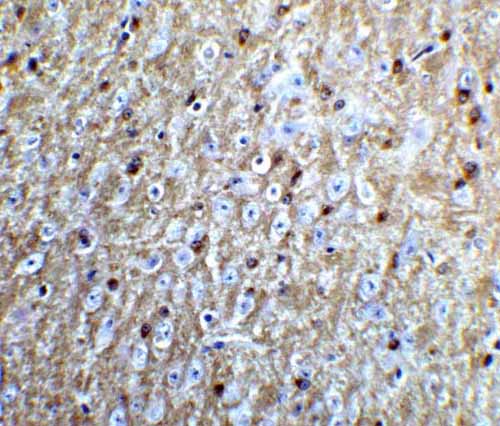PACS2 Antibody
- SPECIFICATION
- CITATIONS
- PROTOCOLS
- BACKGROUND

Application
| WB, IHC-P, IF, E |
|---|---|
| Primary Accession | Q86VP3 |
| Other Accession | NP_056012, 23241 |
| Reactivity | Human, Mouse, Rat |
| Host | Rabbit |
| Clonality | Polyclonal |
| Isotype | IgG |
| Calculated MW | Predicted: 98 kDa Observed: 95 kDa |
| Application Notes | PACS2 antibody can be used for detection of PACS2 by Western blot at 1 - 2 μg/mL. Antibody can also be used for immunohistochemistry starting at 5 μg/mL. |
| Gene ID | 23241 |
|---|---|
| Target/Specificity | PACS2 antibody was raised against a 17 amino acid peptide near the center of human PACS2. The immunogen is located within amino acids 330 - 380 of PACS2. |
| Reconstitution & Storage | PACS2 antibody can be stored at 4℃ for three months and -20℃, stable for up to one year. |
| Precautions | PACS2 Antibody is for research use only and not for use in diagnostic or therapeutic procedures. |
| Name | PACS2 (HGNC:23794) |
|---|---|
| Synonyms | KIAA0602, PACS1L |
| Function | Multifunctional sorting protein that controls the endoplasmic reticulum (ER)-mitochondria communication, including the apposition of mitochondria with the ER and ER homeostasis. In addition, in response to apoptotic inducer, translocates BIB to mitochondria, which initiates a sequence of events including the formation of mitochondrial truncated BID, the release of cytochrome c, the activation of caspase-3 thereby causing cell death. May also be involved in ion channel trafficking, directing acidic cluster-containing ion channels to distinct subcellular compartments. |
| Cellular Location | Endoplasmic reticulum. Mitochondrion |
| Tissue Location | Broadly expressed, with greatest levels in skeletal muscle followed by heart, brain, pancreas and testis |

Thousands of laboratories across the world have published research that depended on the performance of antibodies from Abcepta to advance their research. Check out links to articles that cite our products in major peer-reviewed journals, organized by research category.
info@abcepta.com, and receive a free "I Love Antibodies" mug.
Provided below are standard protocols that you may find useful for product applications.
Background
PACS2 (phosphofurin acidic cluster sorting protein-2), PACS1L, is an 889 amino acid protein that localizes to both the mitochondrion and the lumen of the endoplasmic reticulum (ER) and belongs to the PACS family (1,2). It is expressed in a broad range of tissues with highest expression in skeletal muscle, brain, heart, testis and pancreas (2,). PACS2 interacts with Polycystin-2 and BID and functions as a sorting protein that regulates mitochondria-ER communication and is thought to be involved in ion channel trafficking, specifically direct cluster-containing ion channels to distinct subcellular compartments (3-5).
References
Kottgen M, Benzing T, Simmen T, et al. Trafficking of TRPP2 by PACS proteins represents a novel mechanism of ion channel regulation. EMBO J. 2005; 24:705-16.
Brasacchio D, Noori T, House C, et al. A functional genomics screen identifies PCAF and ADA3 as regulators of human granzyme B-mediated apoptosis and Bid cleavage. Cell Death Differ. 2014; 21:748-60.
Werneburg NW, Bronk SF, Guicciardi ME, et al. Tumor necrosis factor-related apoptosis-inducing ligand (TRAIL) protein-induced lysosomal translocation of proapoptotic effectors is mediated by phosphofurin acidic cluster sorting protein-2 (PACS-2). J. Biol. Chem. 2012; 287:24427-37.
You H and Thomas G. A homeostatic switch in PACS-2 links membrane traffic to TRAIL-induced apoptosis. Cell Cycle 2009; 8:2679-80.
If you have used an Abcepta product and would like to share how it has performed, please click on the "Submit Review" button and provide the requested information. Our staff will examine and post your review and contact you if needed.
If you have any additional inquiries please email technical services at tech@abcepta.com.













 Foundational characteristics of cancer include proliferation, angiogenesis, migration, evasion of apoptosis, and cellular immortality. Find key markers for these cellular processes and antibodies to detect them.
Foundational characteristics of cancer include proliferation, angiogenesis, migration, evasion of apoptosis, and cellular immortality. Find key markers for these cellular processes and antibodies to detect them. The SUMOplot™ Analysis Program predicts and scores sumoylation sites in your protein. SUMOylation is a post-translational modification involved in various cellular processes, such as nuclear-cytosolic transport, transcriptional regulation, apoptosis, protein stability, response to stress, and progression through the cell cycle.
The SUMOplot™ Analysis Program predicts and scores sumoylation sites in your protein. SUMOylation is a post-translational modification involved in various cellular processes, such as nuclear-cytosolic transport, transcriptional regulation, apoptosis, protein stability, response to stress, and progression through the cell cycle. The Autophagy Receptor Motif Plotter predicts and scores autophagy receptor binding sites in your protein. Identifying proteins connected to this pathway is critical to understanding the role of autophagy in physiological as well as pathological processes such as development, differentiation, neurodegenerative diseases, stress, infection, and cancer.
The Autophagy Receptor Motif Plotter predicts and scores autophagy receptor binding sites in your protein. Identifying proteins connected to this pathway is critical to understanding the role of autophagy in physiological as well as pathological processes such as development, differentiation, neurodegenerative diseases, stress, infection, and cancer.


